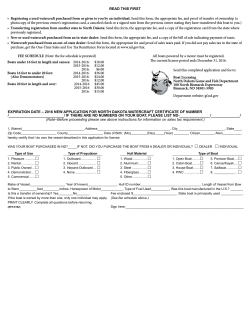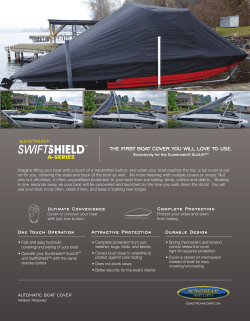
Leaky Lapstrake?
Fall 2006 LEAKY LAPSTRAKE? A LIKELY CULPRIT By Andreas Jordahl Rhude Does your wooden lapstrake boat leak? Have you just accepted the fact that the vessel leaks and you’ve installed a bilge pump, or more than one? Is leaking in a wooden boat inevitable? No legitimate builder of boats, no matter when or what hull material was utilized, made boats that they knew would leak. If you have a boat and it leaks, there is a problem. The annual soaking of a boat’s bottom to get her “watertight” is actually doing more harm in the long run. The swelling and shrinking of the wood – absolutely nothing can be done to prevent this – will ultimately leave gaps, split the boards at fasteners, or break fasteners. Wooden lapstrake power boats such as those built by Thompson, Grady-White, Cruisers, Inc., Old Town and a host of others, have very similar designs and construction. The following sketch shows the basic details of a 1950s and 1960s Thompson: One of the most susceptible places for these boats to leak is at the outer keel and outer stem. These are separate pieces of wood from the keelson (inner keel) and inner stem. These exterior pieces are screw-fastened from the bottom of the boat in to the hull planking and inner keelson/inner stem. The sheets of plywood on the boat’s bottom either side of the centerline are called the garboard planks. They come together at the centerline and are nailed and screwed into the keelson and ribs. Often times, there is a small gap where the two garboards join side to side. At the factory, a flexible marine caulk was run into this gap. This, in turn, was covered by the outer keel and stem. None of the wood was pre-primed or sealed prior to assembly. Over time, this caulk under the outer keel and stem gets dry and brittle and it loses its ability to seal out water. The inevitable swelling and shrinking of the wood through changes in moisture content also contributes to the failure of the caulk. A very simple and effective means to stop the leaking is to recaulk. It is not as difficult as imagined. The following steps will walk you through the process: 1. Clear access must be provided to the outer keel. The boat can be flipped over or blocked up from below. If flipping the boat, make certain it is properly braced. 2 Remove any and all metal stem bands and keel protectors 3. Sand the bottom side/underside of the keel. This will reveal the locations of the putty-filled screw holes. 4. Remove the putty at the screw holes. Use an ice pick or awl. If the outer keel is in good shape and can be reused, be careful not to gouge, chip, or break the wood. If you will make a new white oak outer keel, use the old one as a pattern. 5 On some of these boats, especially Peshtigo built Thompsons, there may be two carriage bolts near the keel/stem joint. This is about at the dashboard of the boat. These go all the way through the outer keel-planking-inner keelson. You should see washers and nuts on the inside of the boat in the bilge. These carriage bolts must be removed. 6. Slowly and carefully remove all the screws. There may be some nails as well (save the screws for future reference). 7. The outer keelson will either readily come off or be stubborn. Pry it off gently. Some adhesion of the old caulk might remain. 8. Clean out all of the old caulk and other gunk. Sand smooth. Also clean & sand the underside of the keel (if it is to be reused). 9 Carefully inspect all wood for rot and splits and other failures. If you have decay, replace the wood; don’t just pour some goop on it. 10. Plug old screw holes in the bottom of the boat with wood plugs. 11.Once clean and dry, seal all the surfaces with a penetrating sealer. After it dries, prime paint. 12. After sealing and priming, dry-fit the keel to the boat. Pre-drill for screw holes and carriage bolts (if any). 13. Caulk the gap between the garboards. Use a flexible marine caulk. Do not use a marine adhesive (such as 3M 5200). 14.Back butter the underside of the keel with the same flexible marine caulk. Be generous. 15. Attach the keel to the boat with new screws and bolts (if any). Be quick, but accurate and careful. Excess caulk will squeeze out. 16. Clean excess caulk and make a smooth fillet with the caulk at the junction of the keel and garboard. 17. Let the caulk dry for several days. 18.Paint with finish coats of paint. 19.`The same steps apply to the outer stem. These steps should waterproof the keel and stem of the boat. If you have leaks at other areas, now is the time to take care of the problem. Wooden boats are not supposed to leak – this is a myth. The above information applies to lapstrake boats made by Thompson Bros. Boat Mfg. Co.; Cruisers, Inc.; T & T Boats, Inc.; Thompson Boat Company of New York, Inc.; and Grady-White Boats. Other boat makers may have used similar design and construction techniques and this fix-it may apply to their boats as well. Materials used: Silicon bronze screws/bolts/nuts/washers (do NOT reuse old fasteners) White oak (all heartwood) for keel and stem Marine grade plywood if replacing any planking. Douglas fir was typically used at the time of construction. Okume is an acceptable modern substitute. Flexible marine caulk such as Life Caulk by Boat Life Prime paint – any high quality marine grade Finish paint – any high quality marine grade Sealer such as Clear Penetrating Epoxy Sealer (CPES) or equivalent PAGE 23
© Copyright 2025












